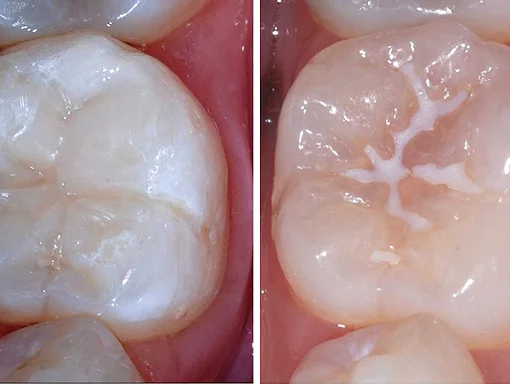
Dental Sealant
Dental sealants are a preventive dental treatment that involves applying a thin, plastic coating to the chewing surfaces of molars and premolars (back teeth). The purpose of sealants is to create a protective barrier that helps prevent the formation of cavities in the deep grooves and pits of these teeth.
The primary purpose of dental sealants is to protect the vulnerable chewing surfaces of molars and premolars, which often have deep grooves and pits that are challenging to clean effectively.
Sealants are typically made of a plastic resin material. The material is applied in a liquid form and then hardens into a thin, smooth, and invisible coating over the tooth surface.
The application of dental sealants is a straightforward and painless process. The steps typically include:
- Cleaning: The tooth is cleaned to remove any debris and plaque.
- Etching: A special gel is applied to the tooth to create a slightly rough surface, which helps the sealant bond effectively.
- Sealant Application: The liquid sealant material is applied to the tooth’s surface and then hardened using a curing light.
Dental sealants are commonly applied to the chewing surfaces of permanent molars and premolars, which typically erupt in children between the ages of 6 and 14. However, adults at higher risk of cavities may also benefit from sealants.
Sealants act as a physical barrier, preventing food particles and bacteria from getting trapped in the deep grooves and fissures of the teeth. This helps reduce the risk of cavities in these areas.
Dental sealants are durable and can last for several years. They may need to be checked during regular dental check-ups, and the dentist can reapply or repair them if necessary.
The application of sealants is a non-invasive procedure, and it typically does not require anesthesia. It is a quick and painless process.
Sealants are often applied to the newly erupted permanent molars in children to provide early protection against cavities. However, individuals of all ages may benefit from sealants, depending on their risk of cavities.
Sealants are not a substitute for regular oral hygiene practices, such as brushing, flossing, and routine dental check-ups. They complement these efforts by providing an additional layer of protection.
Dental sealants are considered a cost-effective preventive measure to reduce the incidence of cavities, especially in the hard-to-reach areas of the back teeth.
Dental sealants are an effective and non-invasive way to protect teeth from cavities, particularly in individuals who may be more prone to tooth decay. Dentists often recommend sealants as part of a comprehensive preventive dental care plan.
